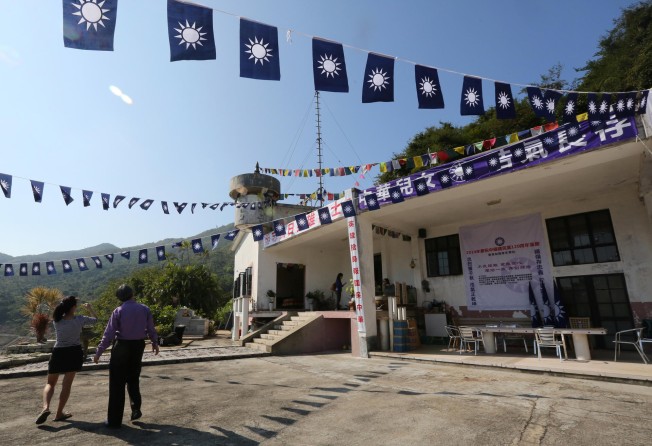KMT supporters' anniversary event highlights fight to save old monastery
Sai Kung District Council's planned heritage centre would clear away remnant of 'Little Taiwan' refugee enclave, shrine

The "blue sky and white sun" flag returned to Tiu Keng Leng yesterday, 18 years after the clearance of the enclave once known as "Little Taiwan" in Hong Kong.
About 70 pro-Kuomintang people in the city, including former residents of the now-demolished squatter area for civil war refugees, celebrated the 120th anniversary of the Revive China Society, a forerunner of the KMT.
Yesterday's event was held at the old Tiu Keng Leng Police Station - the sole surviving building of the former Nationalist refugee enclave - as part of a campaign to save a Tibetan Buddhist monastery inside the building.
The building, also known as Rennie's Mill Police Station, is to be converted into a heritage showroom under a project launched by the Beijing-loyalists-controlled Sai Kung District Council. The move is facing opposition from a group of former residents of the area who are politically tied to Taipei.
The white concrete house was built in 1961 along the Mau Wu Shan hill for the British colonial police to oversee the downhill settlement from 60 metres above. It became home to Po Yin Fat Yuen, a monastery founded in 1956, after the monastery building was torn down in 1996 with the clearance of the squatter area.
Last year, the council decided to turn the building into a new Tseung Kwan O History and Heritage Information Centre, under the government's Signature Project Scheme, which gives each district HK$100 million to launch two projects.
The council hopes to open the centre in 2016. However, under the plan, the monastery is required to move out.
"This is where we pay tribute to war heroes. Removing the shrine is disrespectful to them. The district council is destroying history," said Lau Kin-kwok, the Tiu Keng Leng-born monastery chief. Part of the building now serves as a shrine, with photographs of late Tiu Keng Leng residents for their descendents to pay respects to. Some of them were former Kuomintang soldiers, including Lau's father.
Lau has vowed to defend the shrine and refuses to leave.
While he has been negotiating with the council and government departments, about 40 former squatter residents collected a petition in support of his fight for a meeting in August.
But council vice-chairman Jacky Chan Kwok-kai, who is in charge of the project, said the monastery had been paying only nominal rent for years.
"These are public resources. They can't pay HK$1 rent and use the site forever," said Chan, a member of the Democratic Alliance for the Betterment and Progress of Hong Kong.
The council has identified two alternative sites for the monastery: one in the former Hang Hau Village and another in the Tseung Kwan O Industrial Estate.
Lau is not impressed. "The government can take back a site leased on short-term tenancy terms any time and tenants are supposed to find places to move to by themselves."
Chan said the district council was treating the situation as a special case and hoped the monastery would find a new home.
Under the council's plan, the proposed heritage centre will showcase the modern history of the district, including stories of the Tiu Keng Leng squatter area and the development of the Tseung Kwan O new town.
Former Tiu Keng Leng resident Jacky Cheung Wing-hon, whose late father had a place at the shrine, said he hoped it could remain in its present location.
"My father was in the nationalist army and he fought against the Japanese in Tsingtao [now Qingdao ] … He was among the founders of the Tiu Keng Leng settlement. This is our village."
The two sides could not reach agreement at a meeting on Friday but will meet again next month.